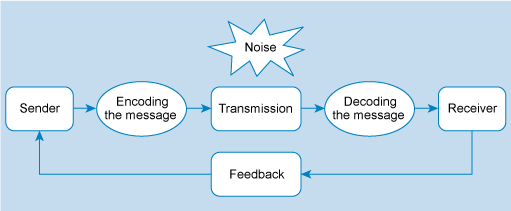3 Communicating with the community and the general public
3.1 The process model of communications
One of the key challenges of communicating with a wider, public audience is to develop effective messages which provide community members, partner organisations and other stakeholders with the information required to achieve a desired outcome. Communication is described by Chris Fill in his book, Marketing Communications: engagements, strategies, practice, as ‘transmission of information, ideas, attitudes, or emotion from one person or group to another’ (Fill, 2005, p. 31). There are many models and frameworks available to help with thinking about or planning communications with community stakeholders or the wider public. The process model of communications in Fig 5 below builds on the basic communication model you saw in Section 2.1.
The main components of this model are explained below:
- The sender is the person starting the communication.
- The message itself (the information the sender wishes to communicate) moves through the diagram and is shown by the arrows.
- Encoding the message turns it into a form which can be transmitted, e.g. written, oral, visual or a combination of two or more. Does it need to be broken down or simplified for the receiver to understand it? Do the sender and receiver use the same language or will some form of translation or interpretation be needed?
- Transmission of the message – for a simple communication between two people this may be a quick chat, a phone call, a written note, a text or a Tweet. For more complex communications or between one sender and many receivers, more planning may be needed.
- Decoding the message is necessary if there is anything about the language the sender uses, or the way it is transmitted which may cause a misunderstanding or misinterpretation by the receiver.
- The receiver is who the message is intended for. In this model the receiver should gain the same understanding of the information as the sender.
- Noise refers to external distractions and sources of miscommunication. In a spoken public address this can literally be noise from the external environment such as traffic, audience chatting or heckling. In an email it could be the arrival of other emails into your inbox.
- Feedback is the receiver’s action on receipt of the information. In Section 2.1 we looked at feedback between sender and receiver as a part of two-way communications between two individuals. Here feedback is different, referring to how the receiver responds to the communication.
Activity 6 Using the process model to assess your communications
In your learning journal jot down a recent situation when you were required to communicate with more than one member of the community where you work, volunteer or live. This may have been a spoken address or request to members of the public. It may have been something written or visual which you presented or displayed. Or it could have been something you circulated over the internet or through social media.
Then consider and write down what actions that communication led to? Did you receive a direct response from one or more of the receivers, or did it prompt the receivers to any form of action positive or negative? From your observations of these actions, write down how effective you think the piece of communication was?
Finally, using the process model of communication explained above, identify what you did well and what you think could improve on to make future communications more effective.
Discussion
No one can expect all individual pieces of communication they send to be perfect but what the model does is help us to analyse the extent to which they are effective in prompting the feedback and action we expect. It also allows us to identify the different stages of how a piece of communication works, to establish whether we can manage any of them better in the future. So for example, you may have been talking in your own first language to some people in a group, for whom this was a second language, and whose grasp of some words you use isn’t so great. You may have used technical or jargon words with which some people are not familiar. You may have chosen a medium which is inappropriate for the message you are conveying. Or it is possible that the environment you are communicating in is just too ‘noisy’.

